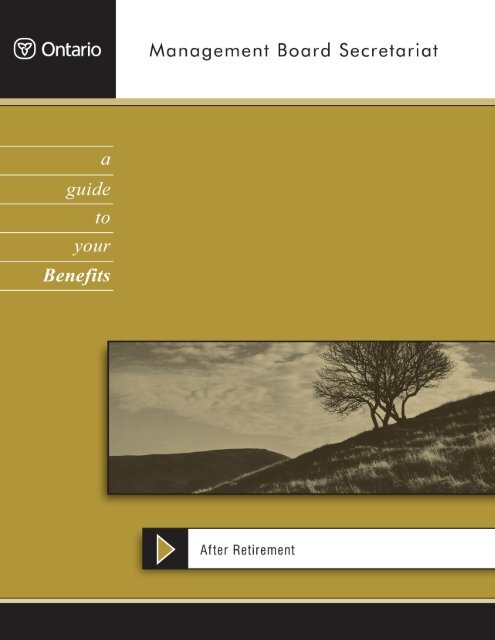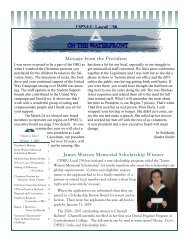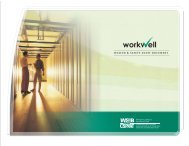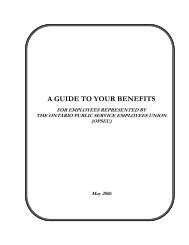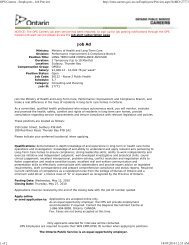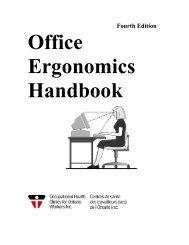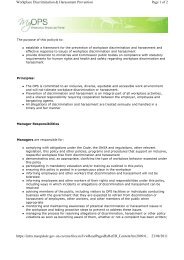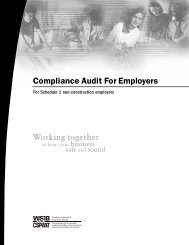Table of Contents - OPSEU Local 736
Table of Contents - OPSEU Local 736
Table of Contents - OPSEU Local 736
Create successful ePaper yourself
Turn your PDF publications into a flip-book with our unique Google optimized e-Paper software.
<strong>Table</strong> <strong>of</strong> <strong>Contents</strong><br />
General Information 1<br />
About this Booklet 1<br />
Eligibility 2<br />
When Coverage Begins 3<br />
Making a Claim 3<br />
Time Limits for Claims 3<br />
How Claims are Processed 4<br />
Co-ordination <strong>of</strong> Benefits 5<br />
Recovering Overpayments 7<br />
Third Party Liability 7<br />
Making an Appeal 7<br />
Definitions 8<br />
Supplementary Health and Hospital 11<br />
Prescription Drugs 11<br />
Hospital Expenses<br />
13<br />
Medical Services and Supplies 13<br />
Paramedical Services 19<br />
Psychologists and Speech Therapists 19<br />
Vision Care and Hearing Aid Coverage 20<br />
What is not Covered 22
<strong>Table</strong> <strong>of</strong> <strong>Contents</strong><br />
Dental Care 25<br />
Fee Guide 25<br />
Deductible 25<br />
Pre-determination 26<br />
Basic Dental Procedures 26<br />
Major Dental Procedures<br />
28<br />
Dentures 29<br />
Orthodontic Procedures 30<br />
Services not Covered 31<br />
Basic Life Coverage 33<br />
Who the Carrier will pay 33<br />
Basic Life for those retiring from the LLBO/LCBO 34<br />
Supplementary Life Insurance 35<br />
Release <strong>of</strong> Information Form 37
General Information<br />
About this<br />
booklet<br />
The purpose <strong>of</strong> this guide is to provide you with a<br />
summary <strong>of</strong> the benefits that are currently available to<br />
you as a retiree <strong>of</strong> the Ontario Public Service (OPS).<br />
This booklet provides information concerning the<br />
benefit Plans but is not a legal document and, in<br />
particular, does not form a contract between the<br />
Ontario Government and you as a retiree.<br />
If there is any discrepancy between the information<br />
contained in this booklet and the group policies issued<br />
by the Carrier, the group policies will govern.<br />
The benefits provided may change from time to time.<br />
Your Benefit coverage is with the<br />
Great West Life Assurance Company.<br />
Policy 44502<br />
Policy 42155<br />
Basic Life Insurance<br />
Supplementary Life Insurance<br />
Supplementary Health & Hospital<br />
Vision Care and Hearing Aids<br />
Dental Care<br />
1
General Information<br />
Eligibility<br />
You are entitled to benefits coverage under this Plan if<br />
you are one <strong>of</strong> the following:<br />
1. a person who is receiving a pension, and who has<br />
credit <strong>of</strong> at least 10 years in the pension plan under<br />
which the pension is paid (the Ontario Pension<br />
Plan and /or the <strong>OPSEU</strong> Pension Plan); or<br />
2. a person who is receiving a pension which is based<br />
on at least 10 years <strong>of</strong> continuous service, and who<br />
has credit in the pension plan for at least some part<br />
<strong>of</strong> those 10 years; or<br />
3. a person who is receiving a deferred pension that<br />
you elected to receive upon terminating<br />
membership in the pension plan during the year<br />
1988 or 1989; or<br />
4. a person receiving a pension paid in respect <strong>of</strong><br />
employment that started between January 1, 1987<br />
and November 3, 1989, and who had reached age<br />
55 at the time <strong>of</strong> employment.<br />
If you qualify, benefits coverage will also apply to your<br />
eligible Dependents (as defined in this booklet). In the<br />
event <strong>of</strong> your death, the coverage will continue to apply<br />
to your eligible surviving Dependents.<br />
Coverage for your surviving spouse will end on his/her<br />
death. Coverage for a surviving Dependent child will<br />
end on the child’s death or on the date the child is no<br />
longer a Dependent as defined, whichever is earliest.<br />
2
General Information<br />
When coverage<br />
begins<br />
Supplementary Health and Hospital Insurance, and<br />
Dental Plan coverage begin on the first day <strong>of</strong> the<br />
month you become eligible for pension payments.<br />
Basic Life insurance and Supplementary Life Insurance<br />
coverage, if elected, begin 31 days after the first <strong>of</strong> the<br />
month coinciding with or following your retirement date.<br />
If you deferred your pension, coverage begins on the<br />
first <strong>of</strong> the month coinciding with or following the date<br />
pension payments begin.<br />
Making a Claim To make a Claim for reimbursement under this Plan,<br />
complete the Claim form that is available from the<br />
Ontario Pension Board or the <strong>OPSEU</strong> Pension Trust, as<br />
applicable.<br />
You must submit your original receipts. Keep a copy <strong>of</strong><br />
the receipts for your own file.<br />
Time limits for<br />
Claims<br />
You incur an expense on the date the medical or dental<br />
service is received or on the date the supplies are<br />
purchased or rented.<br />
In order for you to receive benefits, the Carrier must<br />
receive the Claim by December 31 <strong>of</strong> the year following<br />
the date the expense was incurred.<br />
Receipt by the Carrier means the date that the Carrier<br />
receives the Claim, not the date it is mailed to the<br />
Carrier.<br />
How Claims are Generally, you pay for medical, health or dental<br />
3
General Information<br />
processed<br />
expenses and services directly and submit a Claim to<br />
the Carrier.<br />
The Carrier reviews the Claims against the master<br />
policy for eligibility requirements, age limits, time and<br />
dollar limits and other provisions contained in the<br />
master policy between the Carrier and the Ontario<br />
Government.<br />
If your Claim qualifies for payment, the Carrier will mail<br />
a cheque for the eligible expense to you (or your<br />
survivor) as the insured person.<br />
You are responsible for charges over and above<br />
amounts paid by the Ontario Health Insurance Plan<br />
(OHIP) and amounts that are accepted for<br />
reimbursement under the Supplementary Health and<br />
Hospital Plan or the Dental Plan.<br />
4
General Information<br />
Co-ordination<br />
<strong>of</strong> benefits<br />
If you have family coverage under this Plan and<br />
another benefit Plan, your benefits will be co-ordinated<br />
within this Plan or the other Plan, following insurance<br />
industry standards.<br />
These standards determine where you should send a<br />
Claim first. Here are some guidelines:<br />
If you and your spouse have coverage under different<br />
benefit Plans, the order is as follows:<br />
• If the Claim is for you, send it to your Plan first and<br />
then to your spouse’s Plan;<br />
• If the Claim is for your spouse, send the Claim to<br />
your spouse’s Plan first and then to your Plan.<br />
If you and your spouse are both covered under this<br />
Plan, the Carrier will co-ordinate the payment <strong>of</strong> your<br />
benefits.<br />
If you are Claiming expenses for your children, and<br />
both you and your spouse have coverage, whether the<br />
coverage is under the same or different benefit plans,<br />
you must Claim under the plan <strong>of</strong> the parent with the<br />
earlier birthday (month and day) in the Calendar Year.<br />
For example, if your birthday is May 1 and your<br />
spouse’s birthday is June 5, you must Claim under<br />
your Plan first.<br />
5
General Information<br />
Co-ordination<br />
<strong>of</strong> benefits<br />
(continued)<br />
If you and your spouse are separated or divorced,<br />
the following order applies:<br />
• the Plan <strong>of</strong> the parent with custody <strong>of</strong> the child;<br />
then<br />
• the Plan <strong>of</strong> the spouse <strong>of</strong> the parent with custody <strong>of</strong><br />
the child (that is, if the parent with custody<br />
remarries or has a common-law spouse, then the<br />
new spouse’s Plan will pay benefits for the<br />
Dependent child); then<br />
• the Plan <strong>of</strong> the parent not having custody; then<br />
• the Plan <strong>of</strong> the spouse <strong>of</strong> the parent not having<br />
custody <strong>of</strong> the child.<br />
The maximum amount that you can receive from all<br />
Plans is 100% <strong>of</strong> actual expenses.<br />
When you submit the Claim:<br />
• Determine which Plan you must submit Claims to<br />
first.<br />
• Submit all necessary Claim forms and original<br />
receipts to the first Carrier.<br />
• Keep a photocopy <strong>of</strong> each receipt.<br />
• Once the Claim has been settled with the first<br />
Carrier, you will receive a statement outlining how<br />
your Claim was handled. Submit this statement<br />
along with all necessary Claim forms and receipts<br />
to the second Carrier for further consideration <strong>of</strong><br />
payment, if applicable.<br />
6
General Information<br />
Recovering<br />
overpayments<br />
Third Party<br />
Liability<br />
Making an<br />
Appeal<br />
If you are overpaid for a benefit, the Carrier has the<br />
right to recover all overpayments.<br />
If you or your Dependent have the right to recover<br />
damages from any person or organization with respect<br />
to which benefits are payable by the Carrier, you will<br />
be required to reimburse the Carrier in the amount <strong>of</strong><br />
any benefits paid out <strong>of</strong> the damages recovered.<br />
If you think that you have been improperly denied a<br />
Claim, you may submit a complaint in writing to the<br />
Insurance Appeals Committee for resolution.<br />
Send the information to:<br />
The Secretary, Insurance Appeals Committee<br />
Benefits Policy, Human Resources Division,<br />
Ferguson Block, 13 th Floor<br />
77 Wellesley Street, West<br />
Toronto, ON M7A 1N3<br />
NOTE: the information you send to the Insurance<br />
Appeals Committee must include a completed Release<br />
<strong>of</strong> Information form. See page 37 <strong>of</strong> this booklet.<br />
7
General Information<br />
Definitions<br />
The following is a list <strong>of</strong> definitions <strong>of</strong> some terms<br />
that appear in this retiree benefits booklet.<br />
Capitalized terms that are used in this booklet are<br />
defined to have the meaning set out below.<br />
Calendar year A year starting January 1 and ending December 31.<br />
Carrier<br />
Claim<br />
Conversion<br />
privilege<br />
Deductible<br />
Dependent<br />
The insurance company that provides the coverage.<br />
The form and supporting documents and invoices or<br />
receipts you submit to the Carrier for reimbursement<br />
<strong>of</strong> expenses that are covered under this Plan.<br />
The option to convert a group life insurance policy to<br />
an individual policy, without providing medical<br />
evidence <strong>of</strong> insurability.<br />
The initial amount that you must incur and pay before<br />
receiving reimbursement.<br />
Your Dependent must be your spouse or your child<br />
and a resident <strong>of</strong> Canada.<br />
To be eligible, your spouse must be legally married to<br />
you, or be your partner <strong>of</strong> the opposite sex or <strong>of</strong> the<br />
same sex, who is publicly represented as your<br />
spouse. You can only cover one spouse at a time.<br />
8
General Information<br />
Dependent<br />
(continued)<br />
Your children and your spouse's children (other than<br />
foster children), who are unmarried, until their 21 st<br />
birthday, are eligible Dependents. This includes a<br />
natural or legally adopted child, a child living with you<br />
during adoption probation, or a child living with you<br />
and supported solely by you, and who is your relative<br />
by blood or marriage, or is under your legal<br />
guardianship.<br />
A child who is a full-time student attending an<br />
educational institution recognized by the Canada<br />
Customs and Revenue Agency is also considered an<br />
eligible Dependent until their 26 th birthday as long as<br />
the child is entirely dependent on you for financial<br />
support.<br />
If a child becomes handicapped before their 21 st<br />
birthday, or while a full-time student and before age<br />
26, benefit coverage will continue as long as:<br />
• the child is incapable <strong>of</strong> financial self-support<br />
because <strong>of</strong> a physical or mental disability; and<br />
• the child depends on you for financial support; and<br />
• remains unmarried.<br />
Illness<br />
A bodily injury, disease, mental infirmity or sickness.<br />
9
General Information<br />
Plan<br />
Predetermination<br />
Premium<br />
Reasonable<br />
and Customary<br />
A group Plan under which certain retirees and their<br />
eligible Dependents are insured under a single policy or<br />
contract established between the Ontario Government<br />
and a Carrier.<br />
The process where a dentist submits a treatment plan to<br />
the Carrier before treatment is started. The Carrier<br />
reviews the treatment to determine the work and<br />
amount <strong>of</strong> benefit payment that will be covered.<br />
The amount <strong>of</strong> money paid by you and/or the OPS to<br />
obtain coverage under this Plan.<br />
Fees usually charged for standard medically-approved<br />
services, procedures and supplies normally applied in<br />
the treatment <strong>of</strong> a particular Illness or condition in the<br />
area where the services, procedures and supplies are<br />
performed or supplied.<br />
10
Supplementary Health and Hospital (SH&H)<br />
June 1, 2002<br />
General<br />
description <strong>of</strong><br />
the coverage<br />
The Supplementary Health and Hospital (SH&H)<br />
coverage pays for eligible services or supplies for you<br />
and your eligible Dependents, that are medically<br />
necessary for the treatment <strong>of</strong> an Illness and are not<br />
covered under the Ontario Hospital Insurance Plan<br />
(OHIP).<br />
The OPS pays the entire premium for SH&H.<br />
If you are unsure about coverage, you may call the<br />
Carrier directly to confirm if your Claim costs reflect<br />
the Reasonable and Customary or standard charges<br />
for a particular service or supply.<br />
Prescription<br />
drugs<br />
SH&H covers 90% <strong>of</strong> the cost <strong>of</strong> drugs and medicines<br />
that require a physician’s prescription and are obtained<br />
from a pharmacist.<br />
“Over-the-counter” drugs are not covered under<br />
SH&H.<br />
The drug must have a “Drug Identification Number”<br />
(DIN) as required by section 005 <strong>of</strong> Division I <strong>of</strong> the<br />
Food and Drugs Act, Canada.<br />
The drug cannot be registered under Division 10 <strong>of</strong> the<br />
Regulations to the Food and Drugs Act, Canada.<br />
The claim must apply to a single purchase <strong>of</strong> a drug or<br />
medicine which does not exceed a three month<br />
supply.<br />
11
Supplementary Health and Hospital (SH&H)<br />
June 1, 2002<br />
Prescriptions are subject to the following limitation<br />
regarding generic product substitution:<br />
• SH&H will reimburse you for 90% <strong>of</strong> the generic<br />
equivalent where a generic equivalent exists. If the<br />
brand name product is dispensed, you must pay<br />
the difference between the cost <strong>of</strong> the brand name<br />
product and the 90% <strong>of</strong> the generic equivalent<br />
product cost that is reimbursed by the SH&H Plan.<br />
• However, if no generic product exists, you will be<br />
reimbursed 90% <strong>of</strong> the cost <strong>of</strong> the brand name<br />
product.<br />
Deductible<br />
For prescription drugs the following Deductible applies,<br />
before the 90% reimbursment is paid:<br />
Effective January 1, 2003, the Deductible is $3. 00 per<br />
prescription<br />
Effective January 1, 2004, the Deductible is $5. 00 per<br />
prescription.<br />
For example, effective January 1, 2003:<br />
Eligible cost <strong>of</strong> prescription $27. 00<br />
Less Deductible 3. 00<br />
$ 24. 00<br />
You will be reimbursed: 90% <strong>of</strong> $24. 00 = $21. 60<br />
12
Supplementary Health and Hospital (SH&H)<br />
June 1, 2002<br />
Hospital<br />
expenses<br />
Medical<br />
services and<br />
supplies<br />
SH&H will cover up to $120 per day for the cost <strong>of</strong><br />
hospital room and board, either private or semi-private.<br />
OHIP pays a portion <strong>of</strong> the cost, SH&H pays a portion<br />
<strong>of</strong> the cost and you are responsible for the remainder.<br />
Charges for private or semi-private room and board in<br />
a licensed chronic care or convalescent hospital:<br />
• If you are age 65 or over, SH&H will cover up to<br />
$25 per day for a maximum <strong>of</strong> 120 days per<br />
Calendar year,<br />
• If you are under age 65, up to $120 per day over<br />
the cost <strong>of</strong> standard ward care will be paid by the<br />
Plan.<br />
The Plan will cover 100% <strong>of</strong> the Reasonable and<br />
Customary costs, unless otherwise stated, for the<br />
medical services and supplies listed below which are<br />
medically necessary when ordered by a physician.<br />
• Registered nursing care: pr<strong>of</strong>essional nursing care<br />
services provided in your home, and which only a<br />
graduate registered nurse or registered nursing<br />
assistant can legally perform. The registered nurse<br />
or nursing assistant cannot be a member <strong>of</strong> your<br />
family.<br />
• Services provided by a physician outside your<br />
province <strong>of</strong> residence but within Canada.<br />
• Out patient treatment for charges made by an<br />
13
Supplementary Health and Hospital (SH&H)<br />
June 1, 2002<br />
approved hospital for out-patient treatment<br />
(excluding physician’s fees and special nursing<br />
fees) not covered by OHIP.<br />
• Ambulance service to the nearest hospital qualified<br />
to provide treatment, excluding benefits allowed<br />
under a provincial health plan.<br />
• Radioactive materials; blood, blood products and<br />
their transfusions; and oxygen (including the<br />
equipment necessary for its administration).<br />
• Dental services and supplies provided by a dental<br />
surgeon within a 24-month period following an<br />
accident including:<br />
- treatment <strong>of</strong> accidental injury to natural teeth<br />
(providing the injured teeth were in good<br />
condition before the accident);<br />
- the setting <strong>of</strong> a jaw fractured or dislocated in an<br />
accident.<br />
• 25% <strong>of</strong> the cost <strong>of</strong> an apnoea monitor, which is<br />
approved under the Assistive Devices Program, for<br />
infants who are considered to be at risk from<br />
Sudden Infant Death Syndrome.<br />
• Aerosol equipment, mist tents and nebulizers for<br />
cystic fibrosis, acute emphysema, chronic<br />
obstructive bronchitis, or chronic asthma.<br />
• Iron lung (rental only).<br />
• Two wigs per Calendar Year, following<br />
chemotherapy or alopecia areata, alopecia<br />
14
Supplementary Health and Hospital (SH&H)<br />
June 1, 2002<br />
genetica, alopecia totalis, up to a maximum <strong>of</strong> $100<br />
per wig.<br />
• External breast prostheses and two postmastectomy<br />
bras per Calendar Year.<br />
• Rental <strong>of</strong> wheelchairs, including electric<br />
wheelchairs, for temporary therapeutic use. A<br />
wheelchair may be purchased if recommended by<br />
your physician and if the rental cost would exceed<br />
the purchase cost.<br />
• 50% <strong>of</strong> the cost <strong>of</strong> repairs (including batteries) and<br />
modifications to wheelchairs, up to a maximum <strong>of</strong><br />
$500 for any one repair, battery or modification.<br />
• Rental <strong>of</strong> hospital bed.<br />
• Muscle stimulators when prescribed for treatment<br />
<strong>of</strong> a medical condition, 50% <strong>of</strong> the cost to a lifetime<br />
maximum <strong>of</strong> $500.<br />
• 50% <strong>of</strong> the cost <strong>of</strong> transcutaneous nerve stimulator<br />
(TNS) and 100% <strong>of</strong> all supplies, to a lifetime<br />
maximum <strong>of</strong> $500. 100% <strong>of</strong> electrode replacement<br />
costs, not subject to the $500 maximum.<br />
• Casts, splints (excluding dental splints), trusses,<br />
crutches, canes (including quad canes), walkers,<br />
and cervical collars.<br />
• Braces with rigid supports including lumbar<br />
supports. Orthopaedic shoes if an integral part <strong>of</strong><br />
a brace.<br />
15
Supplementary Health and Hospital (SH&H)<br />
June 1, 2002<br />
• Artificial limbs including myoelectrical limbs and<br />
repair or replacement <strong>of</strong> same.<br />
• Artificial eyes including repairs.<br />
• Corrective straight and reverse last boots.<br />
• Temporary pylon rental following loss <strong>of</strong> leg.<br />
• Six pairs <strong>of</strong> stump socks, per person in a Calendar<br />
Year.<br />
• Four pairs or four sides Jobst support hose or other<br />
elastic support hose per person per calendar year.<br />
• Jobst burn garments when prescribed for burn<br />
treatment.<br />
• Dennis Browne night boots and Beebax bootees.<br />
• Urinal tops and bottoms, plastic gloves, gauze,<br />
lubricating oils and jellies for paraplegics.<br />
• Colostomy apparatus, ileostomy apparatus and<br />
catheters.<br />
• Intermittent positive pressure breathing machines.<br />
16
Supplementary Health and Hospital (SH&H)<br />
June 1, 2002<br />
• 75% <strong>of</strong> the cost <strong>of</strong> custom-made orthopaedic shoes<br />
or modifications to orthopaedic shoes (factory<br />
custom) when prescribed by a physician, one pair,<br />
to a maximum <strong>of</strong> $500 per person in a Calendar<br />
Year.<br />
• 100% <strong>of</strong> the cost <strong>of</strong> orthotics: corrective shoe<br />
inserts, if medically necessary and prescribed by a<br />
physician, podiatrist or chiropractor, one pair, to a<br />
maximum <strong>of</strong> $500 per person per Calendar Year.<br />
• Hydro colloidal dressings.<br />
• Touch vacuum constrictor for impotence, up to a<br />
maximum <strong>of</strong> $500, one claim per lifetime.<br />
• Contraceptive implants, intra-uterine devices,<br />
diaphragms, and 90% <strong>of</strong> oral contraceptives (as a<br />
prescription drug).<br />
• Synvisc injections.<br />
• Microspirometer device.<br />
• Eye glasses and/or contact lenses following<br />
cataract surgery, up to a maximum <strong>of</strong> $50 per eye<br />
per instance <strong>of</strong> surgery.<br />
• 100% <strong>of</strong> the cost <strong>of</strong> insulin syringes, Clinitest,<br />
Dextrose sticks or similar home chemical testing<br />
supplies for diabetics and supplies for blood<br />
glucose monitoring machines and blood letting<br />
devices.<br />
17
Supplementary Health and Hospital (SH&H)<br />
June 1, 2002<br />
• Blood glucose monitoring machines and blood<br />
letting devices for insulin dependent diabetics, up to<br />
a lifetime maximum <strong>of</strong> $300<br />
• 50% <strong>of</strong> the cost <strong>of</strong> medi-jectors , preci-jets and<br />
insulin infusion pumps (including repairs) for insulin<br />
dependent children up to a lifetime maximum <strong>of</strong><br />
$1,000.<br />
• PSA diagnostic tests.<br />
• Lifetime maximum <strong>of</strong> $25,000 for the costs related<br />
to organ transplants.<br />
• Hearing aids, excluding batteries and repairs,<br />
required for treatment <strong>of</strong> hearing disorders <strong>of</strong><br />
children under 10 years <strong>of</strong> age prescribed by an<br />
otolaryngologist or an audiologist.<br />
• The initial purchase <strong>of</strong> a hearing aid or one pair <strong>of</strong><br />
eyeglasses required as a result <strong>of</strong> an accidental<br />
injury.<br />
18
Supplementary Health and Hospital (SH&H)<br />
June 1, 2002<br />
Paramedical<br />
services<br />
Psychologists<br />
and Speech<br />
Therapist<br />
SH&H will cover up to a maximum <strong>of</strong> $25 per visit, with<br />
a Calendar year maximum <strong>of</strong> $1,200 for services<br />
provided by each <strong>of</strong> the following paramedical<br />
specialists, who are licensed and are practising within<br />
the scope <strong>of</strong> their licence:<br />
• Massage therapists, physiotherapists, naturopaths,<br />
osteopaths, chiropractors and podiatrists.<br />
SH&H will cover surgery performed by a podiatrist, in<br />
the podiatrist’s <strong>of</strong>fice, to a maximum <strong>of</strong> $100.<br />
NOTE: Any applicable OHIP maximums must be<br />
satisfied before benefits will be paid.<br />
SH&H will cover up to a maximum <strong>of</strong> $25 per half-hour<br />
visit, with a maximum <strong>of</strong> $1,400 per Calendar Year for<br />
services provided by each <strong>of</strong> the following<br />
paramedical specialists:<br />
• Psychologist (including the services <strong>of</strong> a<br />
practitioner with a Master <strong>of</strong> Social Work who is<br />
performing the services that would otherwise be<br />
performed by a psychologist).<br />
• Speech therapist.<br />
Vision Care<br />
and Hearing<br />
Vision Care and Hearing Aid coverage is an optional<br />
component <strong>of</strong> the SH&H Plan. If you elect this<br />
19
Supplementary Health and Hospital (SH&H)<br />
June 1, 2002<br />
and Hearing<br />
Aid Coverage<br />
Deductible for<br />
Vision Care<br />
and Hearing<br />
Aids<br />
Vision Care<br />
combined coverage package, you pay a portion <strong>of</strong> the<br />
Premium and the Ontario Public Service pays the<br />
remaining portion for each <strong>of</strong> vision care and hearing<br />
aid coverage.<br />
The Deductible is $10 each Calendar Year. For<br />
families, the Deductible is $10 per person, but no more<br />
than $20 altogether.<br />
The Plan will cover 100% <strong>of</strong> the cost <strong>of</strong> contact lenses<br />
and eyeglasses (including repairs), which must be<br />
prescribed by an ophthalmologist or licensed<br />
optometrist up to a maximum <strong>of</strong> $300 per person in any<br />
24-month period.<br />
For example:<br />
• If you purchased eyeglasses and the cost is $300<br />
or more, on September 15, 2002, you will be<br />
eligible for reimbursement if you purchase another<br />
pair <strong>of</strong> eyeglasses, on or after September 16, 2004.<br />
• If your first Claim is less than $300, you may submit<br />
a Claim for the second purchase within the 24-<br />
month period and receive the balance. The 24-<br />
month period still ends on September 15, 2004 and<br />
your next purchase would be eligible on or after<br />
September 16, 2004.<br />
The Plan will not pay for non-prescription sunglasses,<br />
magnifying glasses, or safety glasses <strong>of</strong> any kind.<br />
20
Supplementary Health and Hospital (SH&H)<br />
June 1, 2002<br />
You pay 20% and the OPS pays 80% <strong>of</strong> the total<br />
Premium for vision care.<br />
Hearing Aids<br />
The Plan will pay $1,200 per person, every 4 years for<br />
hearing aids, including cochlear implants, prescribed by<br />
a physician (if required other than as a result <strong>of</strong> an<br />
accidental injury). Expenses incurred for repairs to<br />
existing hearing aids are covered, but eligible expenses<br />
do not include replacement batteries.<br />
NOTE: The Assistive Devices Program, Ministry <strong>of</strong><br />
Health, covers some <strong>of</strong> the cost <strong>of</strong> hearing aids. SH&H<br />
covers the balance to the amount allowed under the<br />
Plan.<br />
You pay 40% and the OPS pays 60% <strong>of</strong> the total<br />
premium for hearing aid coverage.<br />
21
Supplementary Health and Hospital (SH&H)<br />
June 1, 2002<br />
What is not<br />
covered<br />
The SH&H Plan will not cover claims for the following:<br />
• Drugs that do not require a prescription including<br />
medicines obtained at no cost from a physician or<br />
dentist.<br />
• Medicines obtained from a naturopath, homeopath,<br />
chiropractor, or other paramedical practitioners.<br />
• Vitamins, food or food products.<br />
• Charges for hearing aids, eyeglasses, routine eye<br />
examinations and dental services and supplies<br />
(except as specified earlier in this section).<br />
• Expenses covered by a provincial health or hospital<br />
plan, whether or not you or your dependent(s) are<br />
enrolled in either <strong>of</strong> these plans.<br />
• Expenses covered by any other insurance plan or<br />
policy to the maximum allowed by that plan or policy.<br />
• Hospital confinement or services and supplies that<br />
are legally prohibited from coverage.<br />
• Services not listed as covered expenses.<br />
• The difference between a charge made by an<br />
Ontario physician and the maximum charge allowed<br />
by the Ontario resident’s provincial health plan.<br />
• Services and supplies provided by a dental or<br />
medical department maintained by the employer, a<br />
22
Supplementary Health and Hospital (SH&H)<br />
June 1, 2002<br />
mutual benefit association, labour union, trustee or<br />
similar type group.<br />
• Any services or supplies that are not approved by<br />
Health Canada and which are not usually provided to<br />
treat an Illness, including experimental treatments.<br />
• Services or supplies for which no charge would have<br />
been made in the absence <strong>of</strong> this coverage.<br />
• Any injury or Illness for which the person is entitled<br />
to benefits under any workers’ compensation act.<br />
• Examinations required for the use <strong>of</strong> a third party.<br />
• Travel for health reasons.<br />
• Charges incurred outside Canada.<br />
• Cosmetic surgery or treatment (when so classified by<br />
the Carrier) unless such surgery or treatment is for<br />
accidental injuries and commences within 90 days <strong>of</strong><br />
an accident.<br />
• Charges levied by a physician or dentist for time<br />
spent travelling, broken appointments, transportation<br />
costs, room rental charges or for advice given by<br />
telephone or other means <strong>of</strong> telecommunication.<br />
• Charges for delivery <strong>of</strong> prescription drugs.<br />
• Contraceptives, except oral contraceptives or<br />
intrauterine devices.<br />
• Services or supplies needed for sports or recreation<br />
23
Supplementary Health and Hospital (SH&H)<br />
June 1, 2002<br />
that are not medically necessary for regular<br />
activities.<br />
• In-patient confinement in a convalescent hospital<br />
or chronic care facility which is primarily for<br />
custodial care.<br />
• Bodily injury resulting directly or indirectly from<br />
insurrection, war, service in the armed forces <strong>of</strong><br />
any country, participation in a riot or intentionally<br />
self-inflicted injury or disease while sane or insane.<br />
• Certain types <strong>of</strong> medical apparatus and/or devices<br />
may not be covered by the plan. Verify with the<br />
Carrier if unsure <strong>of</strong> coverage.<br />
24
Dental Coverage<br />
June 1, 2002<br />
General<br />
Description <strong>of</strong><br />
the Coverage<br />
The Dental Plan provides coverage for you and your<br />
dependents for eligible expenses that you incur for<br />
dental procedures provided by a licensed dentist,<br />
denturist, dental hygienist, or anaesthetist.<br />
The OPS pays the entire Premium for Dental Care<br />
coverage.<br />
Fee Guide For each dental procedure prior to January 1, 2004,<br />
the Carrier will pay according to the fee stated in the<br />
Ontario Dental Association Fee Guide for general<br />
practitioners. Payments will be based on the guide in<br />
effect at the time the treatment is received.<br />
Effective January 1, 2004, reimbursement <strong>of</strong> eligible<br />
dental expenses will be based upon the previous<br />
year’s Ontario Dental Association Fee Guide for<br />
general practitioners.<br />
Deductible<br />
Predetermination<br />
The Deductible is the portion <strong>of</strong> eligible expenses that<br />
you are responsible for paying. The Deductible applies<br />
to both single and family coverage.<br />
For all dental services, the Deductible is $100 each<br />
Calendar Year for each person, to a maximum <strong>of</strong> $100<br />
per family.<br />
After the Deductible has been paid, expenses will be<br />
paid up to the percentage <strong>of</strong> coverage under this Plan<br />
as outlined below.<br />
You should have your dentist send an estimate to the<br />
Carrier, before the work is done, for any major<br />
25
Dental Coverage<br />
June 1, 2002<br />
treatment or any procedure that will cost more than<br />
$200. Send a completed dental Claim form that shows<br />
the treatment that the dentist is planning and the cost.<br />
The Carrier will tell you how much <strong>of</strong> the planned<br />
treatment is covered under the Dental Plan. This way<br />
you will know how much <strong>of</strong> the cost you will be<br />
responsible for before the work is done.<br />
Any pre-determination <strong>of</strong> benefits by the Carrier is only<br />
valid for 90 days from the date it is received.<br />
Basic dental<br />
procedures<br />
Your dental benefits include procedures used to help<br />
prevent dental problems and to treat basic dental<br />
problems. Basic dental procedures are procedures<br />
that a dentist performs regularly to help maintain good<br />
dental health.<br />
The Plan will pay 85% <strong>of</strong> the eligible expenses for<br />
these procedures after you pay the $100 Deductible.<br />
Examinations • 1 complete examination every 36 months.<br />
• 1 recall examination every 9 months.<br />
• For children 12 and under, 1 recall examination<br />
every 6 months.<br />
• Emergency or specific examinations.<br />
X-rays • full mouth x-rays every 24 months,<br />
• panoramic x-rays every 36 months.<br />
26
Dental Coverage<br />
June 1, 2002<br />
• bitewing x-rays every 6 months<br />
• tests and laboratory examinations; case<br />
presentations; cephalometric films<br />
Preventive<br />
services<br />
• Polishing once every 9 months.<br />
• For Dependent children 12 and under, polishing,<br />
once every 6 months.<br />
• Fluoride treatment is available for Dependent<br />
children only.<br />
• Sedative dressings and discing <strong>of</strong> teeth<br />
Restorative<br />
Services<br />
• Occlusal equilibration up to 8 units <strong>of</strong> time once<br />
every twelve months<br />
• Amalgam, silicate, acrylic and composite fillings;<br />
retentive pins, in conjunction with minor<br />
restorations.<br />
Dental Surgery • Removal <strong>of</strong> erupted teeth, surgical removal <strong>of</strong><br />
teeth; removal <strong>of</strong> residual roots; alveoplasty;<br />
gingivoplasty and/or stomatoplasty; osteoplasty;<br />
surgical excision or incision; fractures and<br />
frenectomy.<br />
Adjunctive<br />
General<br />
Services<br />
Prosthodontic<br />
services and<br />
Repairs<br />
• Including denture repairs, re-lines and re-bases; in<strong>of</strong>fice<br />
drugs and injections; general anaesthesia;<br />
pr<strong>of</strong>essional advice and visits.<br />
• in-<strong>of</strong>fice lab charges, denture repairs, re-lines and<br />
re-bases, re-lines and repairs; limited bridgework;<br />
repairs to existing bridgework, not earlier than three<br />
27
Dental Coverage<br />
June 1, 2002<br />
months after it was put in.<br />
Endodontics • (root canal therapy) including pulp capping,<br />
pulpotomy, root canal therapy, apexification,<br />
periapical services, root amputation, hemisection,<br />
bleaching, intentional removal and apical filling, and<br />
reimplantation, emergency procedures.<br />
Periodontal<br />
treatment<br />
Major dental<br />
procedures<br />
• including surgical, non-surgical and related<br />
services.<br />
Your dental benefits include procedures used to treat<br />
major dental problems. Some examples are crowns or<br />
bridges.<br />
The Plan will pay 50% <strong>of</strong> the eligible expenses for<br />
these procedures after you pay the Deductible. The<br />
maximum amount payable in any Calendar Year is<br />
$1,200 per person.<br />
• Gold foil and metal inlay restorations.<br />
• Metal or plastic transfer coping.<br />
• Inlay, porcelain.<br />
• Crowns.<br />
• Retentive pins in conjunction with major services.<br />
• Bridgework (fixed, once ever 3 years); evaluation,<br />
pontics, retainers (inlay/onlay), repairs, splinting,<br />
retentive pins in abutments, and provisional<br />
28
Dental Coverage<br />
June 1, 2002<br />
coverage during extensive restorations.<br />
• Services and supplies rendered for full mouth<br />
reconstruction, for a vertical dimension correction,<br />
or for corrections <strong>of</strong> a temporal mandibular joint<br />
(TMJ) dysfunction.<br />
• Services and supplies rendered for the correction <strong>of</strong><br />
any congenital or developmental malformation<br />
which is not a Class I, Class II, or Class III<br />
malocclusion.<br />
Dentures<br />
Your dental Plan also includes procedures relating to<br />
dentures.<br />
The Plan will pay 50% <strong>of</strong> the cost <strong>of</strong> dentures to a<br />
lifetime maximum <strong>of</strong> $3,000 per person, after you pay<br />
the Deductible.<br />
• Complete dentures or overdentures, upper and<br />
lower, once every three years.<br />
• Partial dentures, once every three years.<br />
• In-<strong>of</strong>fice lab charges and diagnostic costs, if related<br />
to the above procedures.<br />
• Replacement <strong>of</strong> existing dentures provided the<br />
existing dentures are at least three (3) years old.<br />
29
Dental Coverage<br />
June 1, 2002<br />
Orthodontic<br />
procedures<br />
The dental Plan includes orthodontic procedures for<br />
Dependent children between the ages <strong>of</strong> 6 and 18<br />
only.<br />
The Plan will pay 50% <strong>of</strong> orthodontic costs, up to a<br />
$3,000 lifetime maximum per child, after you pay the<br />
Deductible.<br />
The following orthodontic procedures are covered:<br />
• Observation and adjustment; repairs; alterations;<br />
recementation; separation.<br />
• Orthodontic appliances (braces): removable, fixed,<br />
bilateral and fixed unilateral; retention appliances.<br />
• Preventive services; space maintainers; diagnostic<br />
services; orthodontic casts; my<strong>of</strong>unctional therapy.<br />
• In-<strong>of</strong>fice lab charges, when related to the work<br />
covered by the dental plan.<br />
Payment <strong>of</strong><br />
Orthodontic<br />
Claims<br />
Orthodontic treatment is usually given over a long<br />
period <strong>of</strong> time. Because <strong>of</strong> this – and regardless <strong>of</strong><br />
how you pay your orthodontist’s bill – your dental plan<br />
will reimburse on a monthly or quarterly basis.<br />
Monthly or quarterly benefit payment calculations will<br />
vary, depending on whether your orthodontist provides<br />
you with a single-charge cost estimate or an itemized<br />
estimate.<br />
30
Dental Coverage<br />
June 1, 2002<br />
Transfer <strong>of</strong><br />
dental records<br />
when changing<br />
dentists<br />
You should have your dental records transferred<br />
when you change dentists. Time limits apply to some<br />
<strong>of</strong> the dental Plan services covered under the Plan.<br />
For example, the Plan will cover complete dental<br />
check-ups only once every 36 months. If you have<br />
your records transferred, your new dentist can confirm<br />
when you last received a particular service and<br />
ensure it is not repeated within the applicable time<br />
frame. Doing this can save you money.<br />
You are responsible for the full cost <strong>of</strong> services<br />
performed more <strong>of</strong>ten than is allowed under the<br />
time frames stated in the dental Plan.<br />
Services not<br />
covered<br />
The Plan will not pay for services or supplies that are<br />
not usually provided to treat a dental problem,<br />
including:<br />
• Services fully or partially provided under any<br />
government sponsored hospital or medical plan.<br />
• Services to which the patient is entitled without<br />
charge or for which no charge would have been<br />
made in the absence <strong>of</strong> this coverage.<br />
• Services provided free <strong>of</strong> charge or paid for directly<br />
or indirectly by any government, or for which a<br />
government prohibits payment <strong>of</strong> benefits.<br />
• Cosmetic treatment (other than polishing <strong>of</strong> teeth),<br />
experimental treatment, porcelain crowns on<br />
molars.<br />
31
Dental Coverage<br />
June 1, 2002<br />
• Supplies usually intended for sport or home use, for<br />
example, mouthguards.<br />
• Implants and transplants.<br />
• Expenses <strong>of</strong> dental treatment required as a result<br />
<strong>of</strong> war or <strong>of</strong> engaging, voluntarily or involuntarily, in<br />
a riot or insurrection.<br />
• Services and supplies for dietary planning, the<br />
control <strong>of</strong> dental caries or for plaque control.<br />
• Charges for missed or broken appointments or for<br />
completion <strong>of</strong> claim forms required for the payment<br />
<strong>of</strong> a claim.<br />
32
Basic Life Coverage<br />
June 1, 2002<br />
Basic Life<br />
Insurance<br />
Basic life coverage is optional for all eligible retirees.<br />
If you chose this coverage, the OPS pays the entire<br />
Premium.<br />
Payment <strong>of</strong> basic life insurance Premiums by the OPS<br />
is a taxable benefit. The taxable benefit will be<br />
included as part <strong>of</strong> your income and reflected in your<br />
pension income statement from the Ontario Pension<br />
Board or the Ontario Pension Trust, as applicable.<br />
Your basic life coverage is $2,000 after you retire. It<br />
remains in force for the rest <strong>of</strong> your life.<br />
Who the Carrier<br />
will pay<br />
The Plan will pay the full amount <strong>of</strong> your benefit to<br />
your last named beneficiary on file with the Ontario<br />
Pension Board or the <strong>OPSEU</strong> Pension Trust as<br />
applicable.<br />
If you have not named a beneficiary, the benefit<br />
amount will be paid to your estate. Anyone can be<br />
your beneficiary. You can change your beneficiary at<br />
any time, unless a law prevents you from doing so or<br />
you indicate that the beneficiary is not to be changed.<br />
You should inform the Carrier and the Ontario<br />
Pension Board or the <strong>OPSEU</strong> Pension Trust <strong>of</strong> any<br />
changes that might affect your life insurance, such as<br />
marriage, divorce, death <strong>of</strong> a named beneficiary, or if<br />
you want to change your beneficiary.<br />
33
Basic Life Coverage<br />
June 1, 2002<br />
When and how<br />
to make a Claim<br />
Basic Life for<br />
those retiring<br />
from the<br />
LLBO/LCBO<br />
Claims for life insurance benefits must be made as<br />
soon as reasonably possible. Claim forms are available<br />
from the Ontario Pension Board or the <strong>OPSEU</strong><br />
Pension Trust as applicable.<br />
• If you retired before June 1, 1987, your coverage<br />
is reduced to $3,000.<br />
• If you retired between June 1, 1987 and June 30,<br />
1990, your coverage is reduced to $4,000.<br />
• If you retired on or after July 1, 1990, your<br />
coverage is reduced to $5,000 and will be<br />
reduced again to $4,500 on the October 1<br />
coinciding with or following the date you retire.<br />
34
Supplementary Life Coverage<br />
June 1, 2002<br />
Supplementary<br />
Life Insurance<br />
Employees who cease employment before reaching<br />
age 65 and immediately retire may choose to continue<br />
their previously selected amount <strong>of</strong> Supplementary Life<br />
Insurance coverage.<br />
The Supplementary Life Insurance option applies<br />
only to retirees who were NOT members <strong>of</strong> the<br />
Ontario Public Service Employees Union (<strong>OPSEU</strong>)<br />
or the Ontario Provincial Police Association (OPPA)<br />
or the Liquor Control Board <strong>of</strong> Ontario (LCBO).<br />
Amount <strong>of</strong><br />
coverage<br />
As an active employee you had the option to select<br />
supplementary life insurance coverage <strong>of</strong> one, two or<br />
three times your annual salary.<br />
Employees about to retire can indicate in writing if they<br />
want to keep the same level <strong>of</strong> coverage, reduce it or<br />
discontinue it. You cannot increase coverage to a<br />
higher level.<br />
If you choose to continue this coverage, it will be at the<br />
level you indicate at the time <strong>of</strong> retirement (one, two, or<br />
three times your salary before retirement).<br />
Premium<br />
payment<br />
You pay 100% <strong>of</strong> the premium.<br />
deducted from your monthly pension.<br />
Payments are<br />
Effective date<br />
<strong>of</strong> coverage<br />
Coverage begins 31 days after the first <strong>of</strong> the month<br />
coinciding with, or following, your retirement date.<br />
Termination <strong>of</strong><br />
coverage<br />
Coverage stops at the end <strong>of</strong> the Calendar month in<br />
which you reach age 65.<br />
35
Supplementary Life Coverage<br />
June 1, 2002<br />
Conversion <strong>of</strong><br />
insurance<br />
When and how<br />
to make a Claim<br />
If any or all <strong>of</strong> your insurance terminates on or before<br />
age 65, you may apply to convert your coverage to an<br />
individual policy, without medical evidence. The Carrier<br />
will provide details about the policies that may be<br />
available to you.<br />
Claims for life insurance benefits must be made as<br />
soon as reasonably possible. Claim forms are available<br />
from the Ontario Pension Board or the <strong>OPSEU</strong><br />
Pension Trust as applicable.<br />
36
RELEASE OF INFORMATION<br />
TO: __________________________________________________________________<br />
Insert name <strong>of</strong> Carrier<br />
THIS SHALL BE YOUR AUTHORITY to deliver immediately to the OPS, in care <strong>of</strong><br />
Benefits Policy Section, Human Resource Management and Corporate Policy Division,<br />
Ministry <strong>of</strong> Government Services, Province <strong>of</strong> Ontario, a copy <strong>of</strong> each and every medical<br />
report prepared by or under the authority <strong>of</strong> a medical practitioner, and a copy <strong>of</strong> each and<br />
every document or other paper prepared by any person, in your possession in connection<br />
with my Claim dated<br />
_________________________________________________________<br />
Insert date<br />
_________________________________________________________<br />
Specify benefit Claimed<br />
with the Ontario Public Service.<br />
I understand that this information and material may be used during this insured<br />
benefits appeal.<br />
_____________________________<br />
Date<br />
_____________________________<br />
Signature<br />
_____________________________<br />
Name – Please Print<br />
_____________________________<br />
Home Address<br />
_____________________________<br />
Client ID Number<br />
37


